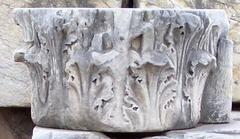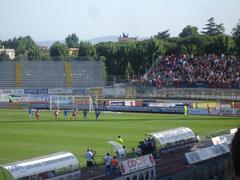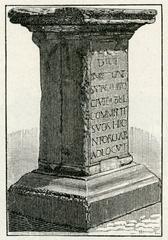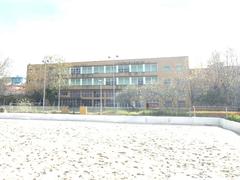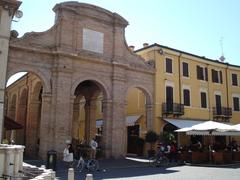Arch of Augustus Rimini, Italy: Visiting Hours, Tickets, and Historical Significance
Date: 15/06/2025
Introduction: The Timeless Landmarks of Rimini
Rimini, a vibrant city on Italy’s Adriatic coast, boasts an extraordinary Roman legacy embodied by two of its most iconic monuments: the Arch of Augustus (Arco d’Augusto) and the Ponte di Tiberio (Tiberius Bridge, also known as Ponte D’Augusto). These enduring structures are more than architectural marvels—they are living witnesses to two millennia of history, engineering, and civic life. As the oldest surviving Roman triumphal arch in Italy and an impeccably preserved Roman bridge, both landmarks invite visitors to explore Rimini’s past while enjoying its lively present.
Whether you are passionate about ancient history, fascinated by classical architecture, or simply seeking authentic Italian experiences, this comprehensive guide provides everything you need: from historical context and architectural features to practical visiting information, accessibility, and travel tips.
Arch of Augustus: History, Architecture, and Significance
Historical Overview
Commissioned by the Roman Senate in 27 BC to honor Emperor Augustus, the Arch of Augustus marks the southern entrance to Rimini’s historic center and the end of the ancient Via Flaminia, the crucial route connecting Rome to the Adriatic (Italyscapes; History Hit; Wikipedia). Constructed from resilient Istrian limestone and standing approximately 17 meters tall, the arch exemplifies the grandeur and symbolism of the Augustan era.
Architectural Features
- Style and Layout: The arch features a single, wide barrel-vaulted opening flanked by Corinthian columns, reflecting the harmonious proportions and decorative richness typical of Roman triumphal architecture (Italyscapes).
- Sculptural Reliefs: Four prominent deities—Jupiter, Apollo, Neptune, and Minerva—are depicted, emphasizing divine protection, military power, and Rimini’s maritime connections (Joey is a Traveler; Italyscapes).
- Construction Techniques: Built with massive limestone blocks fitted without mortar, the arch showcases the ingenuity of Roman engineering (History Hit).
Cultural Significance
Beyond its ceremonial function, the Arch of Augustus symbolized Rimini’s strategic importance in the Roman world and its integration into the empire’s road network. The arch was originally part of the city walls, serving as a grand gateway and enduring symbol of civic pride (Wikipedia).
Ponte di Tiberio (Ponte D’Augusto): Engineering and Urban Life
Origins and Construction
Construction of the Ponte di Tiberio began under Augustus and was completed by Tiberius around 20–21 AD (History Tools; Rimini Sparita). Built entirely from Istrian stone, the bridge measures about 62 meters long and 8.6 meters wide, with five graceful arches spanning the Marecchia River.
Strategic and Civic Role
The bridge marked the beginning of the Via Aemilia and Via Popilia, crucial arteries for commerce and military movement. Its robust design using opus quadratum has allowed it to endure centuries of use, natural disasters, and even the ravages of war (Travel Emilia Romagna; History Hit).
Urban Integration and Community Life
Ponte di Tiberio not only links Rimini’s historic center with the colorful Borgo San Giuliano neighborhood but also serves as a venue for festivals, open-air concerts, and community gatherings, making it a central feature of Rimini’s civic identity (Museionline; VisitRimini).
Practical Visitor Information: Hours, Access, and Tours
Arch of Augustus
- Visiting Hours: Open 24/7; freely accessible at all times (One Day Itinerary).
- Tickets: No entrance fee.
- Accessibility: The arch sits in a flat, open plaza with paved surfaces suitable for wheelchair users. The nearby “Arco d’Augusto” bus stop connects the site to citywide transport (Italyscapes).
- Tours: Local operators offer guided walking tours, often including the arch and other Roman sites for deeper historical context.
Ponte di Tiberio
- Visiting Hours: Open 24/7; free access for pedestrians and (limited) vehicles.
- Tickets: No ticket required to cross or view the bridge.
- Accessibility: The bridge is wheelchair accessible, with ramps at both ends. Note that the stone surface may be uneven in places.
- Getting There: Located at the northern edge of Rimini’s historic center, about a 10-minute walk from Piazza Cavour and close to public transport routes.
Guided Tours and Events
Both monuments are featured in Rimini’s popular guided tours, such as “The Treasures of Rimini” and “Rimini Roman Heritage Walks” (VisitRimini Events). Seasonal events, open-air concerts, and festivals often take place in their vicinity, especially during summer.
Travel Tips and Nearby Attractions
- Borgo San Giuliano: Directly across Ponte di Tiberio, this district is renowned for its vibrant murals, traditional trattorias, and lively festivals like Festa de Borg in September.
- Piazza sull’Acqua: A scenic riverside park adjacent to the bridge, perfect for picnics, photography, and relaxation.
- Museo della Città: Located nearby, this museum houses archaeological finds that contextualize Rimini’s Roman history.
- Local Cuisine: Sample piadina (flatbread) and fresh seafood in neighborhood osterias or riverside cafes.
- Photography: Early morning and sunset provide the best lighting. The illuminated arches at night are especially picturesque.
Accessibility and Responsible Tourism
Rimini’s historic center is pedestrian-friendly and mostly flat, making it accessible for visitors of all abilities. However, some cobblestone surfaces and ancient stonework may require extra care. Visitors are encouraged to:
- Wear comfortable walking shoes.
- Bring reusable water bottles and minimize waste.
- Respect signage and preservation guidelines to protect these monuments for future generations.
Frequently Asked Questions (FAQs)
Q: What are the visiting hours for the Arch of Augustus and Ponte di Tiberio?
A: Both sites are open and freely accessible 24 hours a day, year-round.
Q: Is there an entrance fee?
A: No, both landmarks are free to visit.
Q: Are the sites wheelchair accessible?
A: Yes, both the Arch of Augustus plaza and the Ponte di Tiberio have paved, mostly level access. Take care on uneven stones.
Q: Are guided tours available?
A: Yes, guided walking tours are offered by local tourism offices and private operators.
Q: What other attractions are nearby?
A: Borgo San Giuliano, Piazza sull’Acqua, the Surgeon’s House, and Museo della Città are all within easy walking distance.
Sustainability and Preservation
Ongoing preservation efforts by local and national authorities ensure these historic monuments remain resilient symbols of Rimini’s identity. Visitors play a part by respecting the sites, supporting local businesses, and participating in responsible tourism.
Plan Your Visit
To make the most of your Rimini experience:
- Download the Audiala app for guided audio tours, event calendars, and local insights.
- Explore related articles on Rimini’s Roman heritage.
- Check tourism websites for updated information on tours, events, and accessibility.
Key Takeaways
The Arch of Augustus and Ponte di Tiberio are not just ancient monuments; they are dynamic spaces where history, architecture, and local culture intersect. Their free, round-the-clock accessibility, coupled with Rimini’s lively urban life, makes them essential stops for any visitor. Whether you’re exploring Roman engineering, enjoying festivals in Borgo San Giuliano, or capturing scenic shots at sunset, Rimini’s Roman landmarks promise an unforgettable journey into Italy’s past and present (History Hit; Museionline; Italyscapes; Travel Emilia Romagna).
Further Information and Official Resources
- History Tools – Ponte D’Augusto in Rimini: History, Tickets, and Travel Tips
- Rimini Sparita – Il Ponte di Tiberio
- History Hit – Arch of Augustus Rimini
- Italyscapes – Arch of Augustus Rimini
- Wikipedia – Arch of Augustus (Rimini)
- Joey is a Traveler – Is Rimini Italy Worth a Visit?
- Travel Emilia Romagna – Arch Augustus Rimini
- Museionline – Ponte di Augusto e Tiberio
- VisitRimini – Rimini in One Day: Things to See and Do
- One Day Itinerary – Arch of Augustus Rimini
